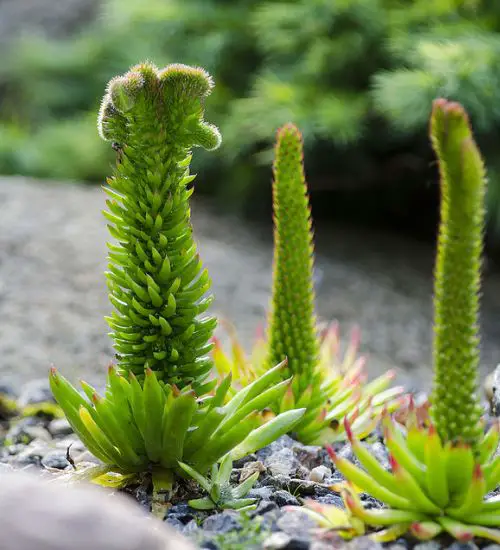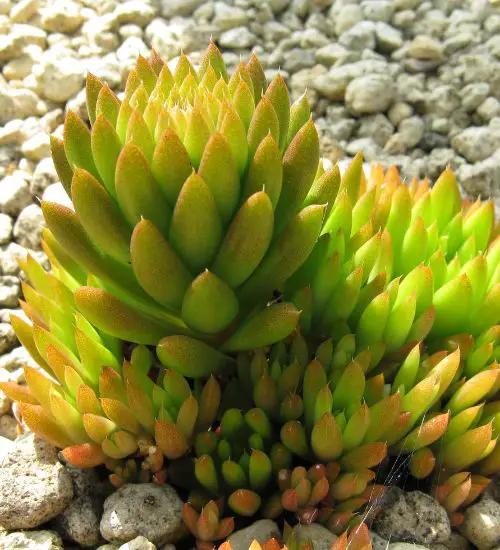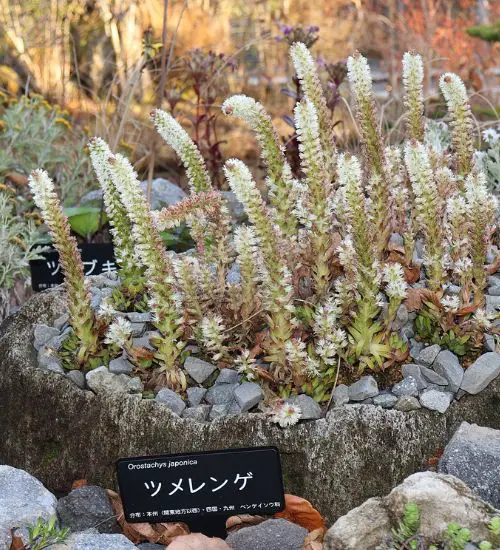Sun: full sun to partial shade
Water: Below average watering needs for a succulent
Temperature: Zone 4a from -4°30F to -25° F (-34.4 ° C to -31.7° C) to Zone 8b from 15° F to 20° F (-9.4° C to -6.7° C)
Winter Survival: Cold hardy
Propagation: offsets, seeds
Flower: in the late summer and early fall
Flower Type: white
Toxic: Generally non-toxic to humans and animals
Dormant: winter
Space Requirement: Indoors & Outdoors
Common Problems: Plants may rot if overwatered
Where to buy Orostachys Japonica?
Basc Care for Orostachys Japonica
Watering
What you need to remember is that this type of succulents needs to be watered for every 2 weeks
You can water your succulent more than often in extreme conditions but make sure that the soil is completely dry before watering your succulent again.
Fertilizing
Only feed this succulent during its active growing seasons which means winter. Use the right fertilizer applied in the right amounts. Applying half-strength balanced fertilizer every month or so is recommended for optimal results.
Do not fertilize during winter as the plant is dormant.
Sun & Location Requirements for "Rock Pine"
Orostachys Japonica needs full sun to partial shade in order to thrive. While this variety needs plenty of bright light, it is important not to place it in direct sunlight for extended periods of time as this can cause damage or scorching to the leaves and stems. A shadier spot with indirect light could be just what "Rock Pine" needs.
As per this succulent profile, it is only able to stay healthy when the environment temperature is above the range of zone 4a from -4°30F to -25° F (-34.4 ° C to -31.7° C).
Orostachys Japonica is one of the most cold hardy succulents available, capable of surviving temperatures down to 0°F. Its thick leaves and stems help retain moisture in its cells and protect it from frigid winter weather. The succulent's attractive foliage adds a touch of cheerfulness to any cold-weather garden. "Rock Pine" is an ideal choice for areas with freezing temperatures during the winter months.
Any succulents in the group will need a medium space to grow. You can place your pot at your table or window. Since this plant needs more space than mini succulents, you should consider do not plant them together with other succulents/plants.
Orostachys Japonica also benefits from some indirect light throughout the day as well, so make sure you give it enough space to soak up light without becoming too exposed to heat.
Propagation
Succulents can be propagated easily by taking offsets from the mother plant and replanting them in fresh soil. The offset will eventually grow into a new succulent that is identical to its parent.
Growing Orostachys Japonica from seeds is an easy and economical way to produce more plants. Identify a healthy seed by its plumpness, dark color and slightly sticky texture. Once the potting mix has been pre-mixed with well-draining soil, sow the seeds evenly and press lightly into the surface. To ensure germination, keep the container in bright but indirect light and mist the soil gently with a spray bottle.
Toxicity

Orostachys Japonica is generally non-toxic to humans and animals. However, it is important to be aware that certain parts of the plant may contain toxins which can cause mild skin irritation. It is advised that you keep the plants away from small children or pets, as they may unknowingly ingest them and suffer ill effects.


